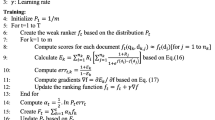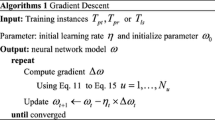Abstract
Relevance ranking has been a popular and interesting topic over the years, which has a large variety of applications. A number of machine learning techniques were successfully applied as the learning algorithms for relevance ranking, including neural network, regularized least square, support vector machine and so on. From machine learning point of view, extreme learning machine actually provides a unified framework where the aforementioned algorithms can be considered as special cases. In this paper, pointwise ELM and pairwise ELM are proposed to learn relevance ranking problems for the first time. In particular, ELM type of linear random node is newly proposed together with kernel version of ELM to be linear as well. The famous publicly available dataset collection LETOR is tested to compare ELM-based ranking algorithms with state-of-art linear ranking algorithms.


Similar content being viewed by others
References
Cossock D, Zhang T (2008) Statistical analysis of Bayes optimal subset ranking. IEEE Trans Inf Theory 54(11):5140–5154
Nallapati R (2004) Discriminative models for information retrieval. In: Proceedings of the 27th annual international ACM SIGIR conference on Research and development in information retrieval. SIGIR ’04. ACM, New York, 25–29 July, pp 64–71
Li P, Burges CJC, Wu Q (2007) Mcrank: learning to rank using multiple classification and gradient boosting. In: Platt JC, Koller D, Singer Y, Roweis ST (eds) NIPS. MIT Press, Cambridge
Vapnik VN (1998) Statistical learning theory. Wiley, New York
Suykens JAK, Vandewalle J (1999) Least squares support vectormachine classifiers. Neural Process Lett 9(3):293–300
Burges C, Shaked T, Renshaw E, Lazier A, Deeds M, Hamilton N, Hullender G (2005) Learning to rank using gradient descent. In: Proceedings of the 22nd international conference on machine learning. ICML ’05, ACM, New York, pp 89–96
Tsai MF, Liu TY, Qin T, Chen HH, Ma WY (2007) Frank: a ranking method with fidelity loss. In: Proceedings of the 30th annual international ACM SIGIR conference on Research and development in information retrieval. SIGIR ’07, ACM, New York, pp 383–390
Freund Y, Iyer R, Schapire RE, Singer Y (2003) An efficient boosting algorithm for combining preferences. J Machine Learn Res 4:933–969
Joachims T (2002) Optimizing search engines using clickthrough data. In: proceedings of the eighth ACM SIGKDD international conference on Knowledge discovery and data mining. KDD ’02, ACM, New York, pp 133–142
Pahikkala T, Tsivtsivadze E, Airola A, Boberg J, Salakoski T (2007) Learning to rank with pairwise regularized least-squares. In: Joachims T, Li H, Liu TY, Zhai C (eds) Proceedings of the SIGIR 2007 workshop on learning to rank for information retrieval. ACM, Amsterdam, Netherlands, pp 27–33
Huang GB, Zhu QY, Siew CK (2006) Extreme learning machine: theory and applications. Neurocomputing 70(1–3):489–501
Huang GB, Chen L, Siew CK (2006) Universal approximation using incremental constructive feedforward networks with random hidden nodes. IEEE Trans Neural Netw 17(4):879–892
Huang GB, Chen L (2007) Convex incremental extreme learning machine. Neurocomputing 70:3056–3062
Huang GB, Chen L (2008) Enhanced randomsearch based incremental extreme learningmachine. Neurocomputing 71:3460–3468
Huang GB, Ding X, Zhou H (2010) Optimization method based extreme learning machine for classification. Neurocomputing 74:155–163
Huang GB, Zhou H, Ding X, Zhang R (2012) Extreme learningmachine for regression and multi-class classification. IEEE Trans Syst Man Cybern 42(2):513–529
Huang GB, Wang D, Lan Y (2011) Extreme learning machines: a survey. Int J Mach Learn Cybern 2(2):107–122
Weisstein EW (1995) Laplacianmatrix. [Online]. Available: http://mathworld.wolfram.com/LaplacianMatrix.html
Qin T, Liu TY, Xu J, Li H (2010) Letor: a benchmark collection for research on learning to rank for information retrieval. Inf Retr 13(4):346–374
Baeza-Yates RA, Ribeiro-Neto B (1999) Modern Information Retrieval. Addison-Wesley Longman Publishing Co., Inc., Boston
Järvelin K, Kekäläinen J (2000) In: Proceedings of the 23rd annual international ACM SIGIR conference on Research and development in information retrieval. SIGIR ’00, ACM, New York, pp 41–48
Author information
Authors and Affiliations
Corresponding author
Rights and permissions
About this article
Cite this article
Zong, W., Huang, GB. Learning to Rank with Extreme Learning Machine. Neural Process Lett 39, 155–166 (2014). https://doi.org/10.1007/s11063-013-9295-8
Published:
Issue Date:
DOI: https://doi.org/10.1007/s11063-013-9295-8




